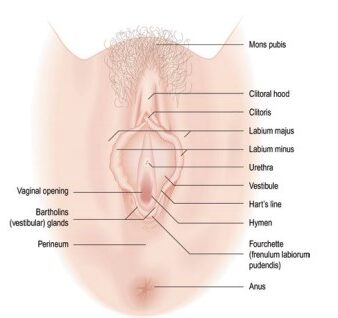Vulvodynia is pain of the vulva that has been going on for at least 3 months, without a clear cause or objective physical findings to explain the symptoms. The pain may be spontaneous, or provoked by touch. In addition to experiencing pain with vaginal penetration, people with vulvodynia may experience burning and or itching sensations at the vulva that are aggravated by contact from clothing, movement, and pressure from sitting.(1)
There are many conditions that can cause vulvar pain. Before vulvodynia is diagnosed, other pain generating factors should be ruled out, including neurological conditions, infection, inflammation, estrogen deficiency, or trauma to the vulva.(1)
While we’re discussing the vulva, let’s do a quick anatomy review:
The vulva consists of the mons pubis, labia majora, labia minora, hymen, clitoris, vestibule of the vagina, urethral orifice, Skene’s glands, Bartholin’s glands and the vestibular bulb(1). Vulvodynia is not to be confused with vestibulodynia, which refers to pain limited to the vestibule or area around the vaginal opening between the labia minora and the hymen. Think of it as the “foyer” leading to your vagina.
Pain without a clear cause? What is going on?
First, let’s talk about pain. The International Association for the Study of Pain defines pain as “An unpleasant sensory and emotional experience associated with actual or potential tissue damage, or described in terms of such damage.”(2)
Let’s dive deep for a second and think about how pain is produced in the body. We have these little sensory neurons called nociceptors and they detect stimulus at the skin. Nociceptors’ jobs are to detect extreme temperatures, pressure and or chemicals that could damage our tissues and to relay information to the brain about what’s going on.(3)
Sometimes these nociceptors become overly sensitive, meaning a stimulus that ordinarily wouldn’t be perceived as painful becomes painful. This can happen due to an increase in the number of nociciceptors or a reduction in their threshold (meaning, it takes less intense of a stimulus for the nociceptors to alert the brain). Think of it as a really sensitive smoke detector. Imagine someone calibrated your smoke detector to be so sensitive that it goes off when you preheat your oven to bake cookies.
And we care about this because?
Studies have shown that people with vulvodynia often have sensitized systems, including increased density of nociceptors in the vestibular mucosa. So even though your healthcare provider rules out infection, inflammation, etc., you are still feeling pain and it is very real! We believe you!
What can be done to help reduce pain associated with vulvodynia?
Pelvic floor physical therapists work with an interdisciplinary team to provide care to people with vulvodynia. Sometimes oral or topical medications are prescribed by a physician to help alleviate pain and sensitivity.
Often the first thing we recommend in therapy is to take a look at what products may be contributing to vulvar irritation. For example, the following items may aggravate the vulva: synthetic underwear, tight pants, scented soaps and laundry detergents, bubble bath, wipes, “femine wipes” (you don’t need those, by the way!) and certain types of lubricants (see our blog “Let’s Get Slippery to learn more!) Stay tuned for other blogs about vulvar skin care as well.
Sometimes chronic vulvar pain can lead to muscular tension at the pelvic floor that amplifies the pain cycle. Physical therapists have an extensive toolkit to assess and treat this muscular tension, including manual therapy, stretches and exercises, education in relaxation strategies sometimes including biofeedback which allows people to monitor and release muscle activity.
If you are experiencing pain at the vulva that is interfering with your quality of life, please know you are not alone! We would love to see you and help you meet your goals, whether they include sitting without pain, engaging in physical intimacy, riding your bike or wearing your favorite pair of pants!
- Faye RB, Piraccini E. Vulvodynia. [Updated 2020 Apr 28]. In: StatPearls [Internet]. Treasure Island (FL): StatPearls Publishing; 2020 Jan-. Available from: https://www.ncbi.nlm.nih.gov/books/NBK430792/
- “IASP Terminology.” IASP, www.iasp-pain.org/Education/Content.aspx?ItemNumber=1698.
- Dubin AE, Patapoutian A. Nociceptors: the sensors of the pain pathway. J Clin Invest. 2010;120(11):3760-3772. doi:10.1172/JCI42843


